From
Prickly Paragraphs: WHITE ADROMISCHUS
A
Commemorative Cornucopia, published by Coventry
& District Branch BCSS (1987)
by the late Bryan Makin [Other articles by BM on
this web site: A.
hemisphaericus,
A. leucophyllus.]"When
one has been keen on a particular genus for forty
years, as I have on Adromischus, it is not
unusual to be asked about favourites. I have no
hesitation in stating my great liking for those
with white or near-white leaves. It is not that
they are necessarily the most beautiful, though
beauty is a matter of personal taste anyway, but
there is something about the white ones which
makes me wish never to be without them, and makes
them just that little bit special.
Botanically, they are a
mixed bag. They may fall into just two of the
five Sections of Tölken's revised genus, but
visually they differ quite a lot. It is this
considerable diversity within a small number of
species and forms that adds greatly to their
aesthetic appeal in my eyes.
The species concerned are AA.
leucophyllus, marianiae
var. hallii,
umbraticola and subviridis, plus one natural hybrid, which I
have seen but never grown. There is no special
significance in that order except that A.
leucophyllus, whose name means
"white-leaved", is the one which
obviously springs to mind first, so I'll start by
discussing that one.
| A.
leucophyllus was one of the first
Adro's I grew, back in 1947, when I
rooted a leaf that had come down to me
from a plant of J. T. Bates and I've
never been without it since. It grows
very readily from leaves and soon makes a
presentable plant, an inch or two high
with oval, slightly convex leaves densely
covered in white meal or farina. Covered,
that is, until one accidentally touches a
leaf and the meal smudges off, never to
return. There's only one thing for it
then - to remove the offended leaf and
place the pot somewhere a bit safer. That is the main drawback to
this species, but no reason at all for
not growing it. The leaf you take off
will make a new plant and give you a
second chance of producing an object of
pristine loveliness. The ease with which
a plant can be spoilt by even a moment's
carelessness adds enormously to the
chances of a perfect specimen in a show,
because it should gain full marks for
difficulty of cultivation at the very
least. Rarity counts for very little, so
it hardly matters that it isn't rare.
However, even the odd point for rarity
could be picked up if you have the
uncommon red-spotted form.
|
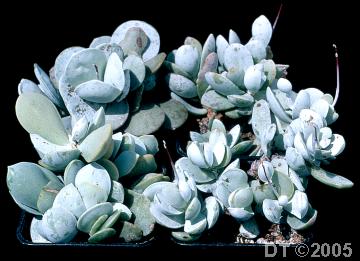
Four clones of A.
leucophyllus in 2 3/4" pots. |
For some
reason this red-spotted form appears only at the
higher altitudes in the wild. It was quite a
surprise when I first came across such plants in
1954 as I had no idea the spotted form existed. I
came across a stand of it, not just a single
specimen, on top of a ridge above the little town
of Montagu at the western end of the Little
Karoo, yet all the plants on the lower slopes had
been of the pure white form. In the spotted
plants, the meal was either very thin or entirely
missing on the spots themselves, so that they
stood out against the otherwise white leaf to
give a very striking result.
At that time, it
was thought that Montagu was the only
habitat of this species and so it was
stated when the species was validly
described and named in the NCSS Journal
later in 1954. It was a surprise to find
that this plant, which was widely known
under the very apt name of "A.
leucophyllus", had never been
validly published, but this was put right
by Uitewaal, using also some habitat
details which I had contributed. However,
Harry Hall found the same species in the
Anysberg region, some fifty miles or so
north-east of Montagu. Subsequently Peter
Bruyns came across it in several places
in the Witteberg range to the north and,
in 1985, I found it at the top of a
mountain in the Rooinek Pass, south of
Laingsburg and much further east than the
previous localities. Thus the habitat
range of A. leucophyllus is now
known to be much wider than originally
thought.
|
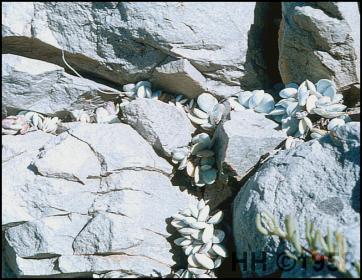
A. leucophyllus
photographed by Harry Hall in 1958 near
Montagu. |
As in my
earlier discovery in 1954, the high altitude
plants in the Rooinek Pass turned out to be the
spotted form, but I didn't find any with the very
dark red spots that I'd seen above Montagu.
Surprisingly, there were no plants on the middle
slopes like there had been at Montagu.
Apart from its touch-me-not
quality, A. leucophyllus is very straightforward
in cultivation. It accepts a winter rest period
and flowers in summer producing pure white flower
stems and buds and pink wide-open flowers. The
spent flower stems must be removed with the
utmost care to avoid damage to the leaves and, of
course, bright light produces compact growth.
| Having already
mentioned Harry Hall, I will now consider
the species which was named after him by
P.C. Hutchison - A. hallii - but
which has since been revised by Helmut
Tölken as A. marianiae var. hallii
- same plant but now needs a bigger
label! The
type locality for this one is at the foot
of the Buchu Twins (mountains) in the
"diamond area" to the north of
Alexander Bay. [DT: an error - Hutchison
in the original CSJA description quotes
Harry Hall as explicitly identifying the
TL as the other Buchu Twins mountains,
"about ten miles south of Alexander
Bay", nowadays mapped as the
Boegoeberg-Noord & Suid]. It was
there that Harry Hall first found it in
the full glare of the sun, but snuggled
down in sandy pockets in the rocks, as a
protection against the perpetual
sand-blasting along that windy coast.
|

A. marianiae
var. hallii as grown by Bryan. |
Even in
cultivation it maintains a very low profile with
growing points slowly spreading in a tight,
fleshy base over thick, tuberous roots. The
typical form has fat, rounded leaves with a horny
margin which, in the wild, is often dark red and
shows up well against the nearly white, waxy
bloom which covers the rest of the leaf. The
degree to which both of these features is
achieved in cultivation is governed by the amount
of strong light falling on the plant. A shelf
near the glass is indicated, but I have seen a
very nice specimen on the staging of a fully
exposed greenhouse in West Yorkshire.
| Since that first
discovery, plants have been found in
other parts of N.W. Namaqualand and in
southern S.W.A./Namibia, which must be
referred to this variety although some
differ a lot in shape and markings.
Plants with more pointed leaves, less
white in colour but bearing dark red
spots were found near Umdaus, in the
Richtersveld, by Harry Hall and, in the
Tölken concept, these have to be that
variety. Tölken himself figures a
similar form from south-west Namibia. I
have found this form to be much slower in
growth than the type but it does produce
a very similar, short, stocky flower stem
covered in white bloom. When Tom Jenkins visited
S.W.A./Namibia he found Adromischus
plants in the Obib Mountains and others
in the Aurus Mountains which have turned
out to be this variety, plain-leaved and
biconvex like the type, though less white
in colour. My plant of the Obib form
lacks the dark red, horny margin, but the
Aurus one develops it very readily and is
making a very tight and attractive mound.
|
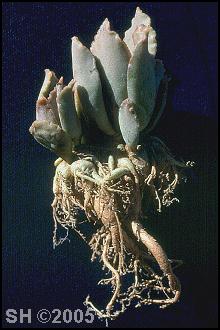
A. schuldtianus subsp. juttae , SH1383
from Naip, Bushmanland. |
More
recently a form has been collected on the Naip
Plateau, in north-western Bushmanland, which has
rather longer and flatter, lanceolate leaves with
a wavy, horny margin at the ends. This is a very
attractive, tight-clustering plant with the
typical stocky, white flower stem, but its colour
is more of a pinky-grey than white. [DT: This
appears to be a westerly A. schuldtianus subsp. juttae from the photo.]
Back in the late
fifties, Vera Higgins gave me a piece of
a plant which, on leaf shape at least,
seemed to be the recently published A.
hallii P.C. Hutch., though it wasn't
as white. When it flowered, however, it
was clearly something else and, when
P.C.H. visited me in 1960, he identified
it as a very squat-leaved form of A.
umbraticola, an eastern species from
the Transvaal. Whilst most of the forms
are not at all white, there is one that
is and it has the twin virtues of being
well distributed and easy to grow. The
sturdy oblanceolate leaves are densely
covered in white to pinkish-white, waxy
meal and there is a dark red horny margin
round the end. It forms a dense, squat
plant and produces whitish flower stems
which often tend to droop forwards as
they develop before finally
straightening.
|

One of Bryan's Adromischus
umbraticolas. |
A.
umbraticola belongs in a botanical Section
of just three species, called Boreali which means
"northern" (as in Aurora Borealis - the
Northern Lights) since they include the most
northerly occurring of all the species of
Adromischus. There is one feature about the
inflorescence of these three which differs
noticeably from all the rest, though I've never
seen it mentioned in anything I've read. Although
the individual buds arise spirally from the axis
of the flower stem, they twist round so that by
the time they open they are facing more or less
in the same direction and not necessarily towards
the sun.
| Beautiful though
the white A. umbraticola is, I
have recently received a leaf from an
enthusiast in California in which the
white surface is well broken up by red
spots and blotches, so this promises to
develop into a real cracker. The
last species in my list is one which has
intrigued me for a long time, ever since
I first met up with it in the early
fifties, when a newly-found plant arrived
from my late friend Harry Hall. Material
was also sent to Paul Hutchison, at the
University Botanical Garden in
California, who recognised it was a
completely new species. He proposed to
grow and flower it and then publish a
description under the name 'A.
farinosus'. However, events overtook
him and he left Botany before this could
be done and the plant remained
undescribed.
|
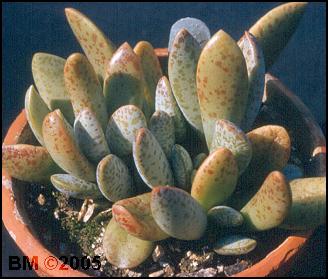
Possibly Bryan's red
spotted A. umbraticola. |
By
Adromischus standards this is a medium-tall
plant, stem forming and with large dorsiventrally
flattened leaves with a sharply keeled margin,
variably decorated with red spots and blotches
and the whole plant covered in a white bloom or
farina. Some plants have narrower leaves than
others, but the big surprise comes at flowering
time. Although the leaf shape and size are
similar to the more southerly species A.
maculatus, the flower structure obviously
places it with that Section of the genus which
contains A. marianiae var. hallii
and within which, it stands out as a veritable
giant.
In 1978 Tölken
published his new species A.
subviridis, based on a single plant
collected in the Blaukranz Pass. After
some consideration on my part, since
there was no illustration to help, it
became clear that this was indeed the
same species as the now old, but
unpublished, 'A. farinosus'
which had proved tricky to grow and was
therefore hardly known in cultivation.
Obviously Tölken didn't know it and I
knew it had not survived long in
Kirstenbosch. Such differences as there
were between the description of A.
subviridis and my remaining material
could be reasonably ascribed to Tölken
having found only the one specimen and
the location being some miles further
east, which could introduce some extra
element of variation.
|

'A. farinosus'
photographed by Bryan near Grasberg. |
It became my
great wish to seek out this species in the wild,
but I was to make two fruitless attempts, before
I finally succeeded at the third. I decided, this
final time, to arrive in the area via the
Blaukranz Pass and spend the night close to where
'A. farinosus' had been found. After the
two earlier attempts, I realised that the modern
road probably did not follow the precise line
that the old dirt road had taken, so I took the
precaution of contacting a farmer in the area who
was willing to show me where the old road was.
| Unfortunately,
Blaukranz Pass was reached very late in
the afternoon and I had driven right
through the long pass before I realised
that the only possible stopping place on
such a narrow, twisting road by then lay
some miles back. So I had to press on and
abandon any search in the Pass. An early
start the next morning led to the
realisation of my dream and I was able to
walk at last among scores of plants of
this superb Adromischus. The gleaming
whiteness of the leaves made them stand
out against whatever background with an
almost infinite variation in the red
markings. I
collected some leaves, but one of the
unusual features of this species is that
leaves are by no means certain to produce
plants. Even now, after more than a year,
barely half of them have made shoots and
I have already given away all I dare. My
walk amongst the wild plants confirmed my
belief that there would be variation
enough to accommodate the narrow leaf in
Tölken's description of his single
specimen, so I have no doubt that my
plants are A. subviridis. A pity
I could not search in the Pass, but the
planned itinerary allowed no time to go
back.
|
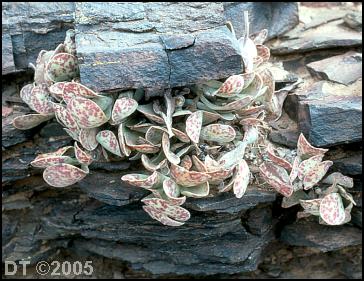
An unusually large and
dehydrated A. subviridis photographed
by DT at Karoskloof. |
Finally a
fisherman's tale of the one that got away; the
hybrid I mentioned earlier as having seen but
never grown, and for this we must go back to
Montagu and 1954.
I spent two days studying
the Adromischus on the hillside and ridge that I
referred to and there were also other species
than A. leucophyllus growing there. On
the flat ground as I left the road, for instance,
were spreading plants of what is now known as A.
filicaulis subsp. marlothii but which
many of us still grow as 'A. mammillaris'.
This gave way on the lower slopes to fine plants
of a large-leaved form of A. maculatus
where hardly two plants had identical markings.
In turn these gave way, on the barer middle
slopes, to the pure white A. leucophyllus.
This gave out way below the ridge and was
replaced at the top by spotted forms of the same
and, in one small area, by several plants of A.
caryophyllaceus, a rather dull green plant
but with large and striking flowers.
It occurred to me
whilst I was still at the top on the
second day, that both the A.
maculatus and A. leucophyllus
were in flower down below me. It might be
a worthwhile exercise on the way down to
cast about along the line where they came
closest together, to see if I could spot
any evidence of hybridisation. I spent
quite a long time at this and was almost
ready to give up when I spotted it,
hidden from view on the approach side by
a sheltering shrub, but suddenly fully
visible as I looked back and stopped in
amazement. I hadn't really known what I
was looking for but, unmistakably, this
was it.
|
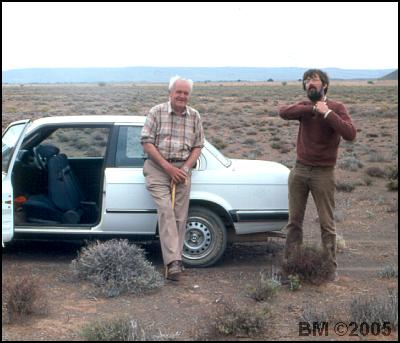
Farmer Mr Buhr and
Steven Hammer prepare for a day in the
veld around the Grasberg farm in 1985. |
It was a
substantial plant with several stems or branches
and large thick leaves, thicker it seemed than
the A. maculatus but not quite as big.
They were freely decorated with red spots and
every other portion of the leaf was heavily
covered in a pure white meal, as dense as the
densest A. leucophyllus. It was so
beautiful that I just hadn't the heart to dig it
up. So I cut off one stem and carefully put it in
my bag. The most beautiful Adromischus I've ever
seen and yet I've never grown it. I mailed home
five parcels of plants from my first trip to
South Africa. One box never arrived.
|